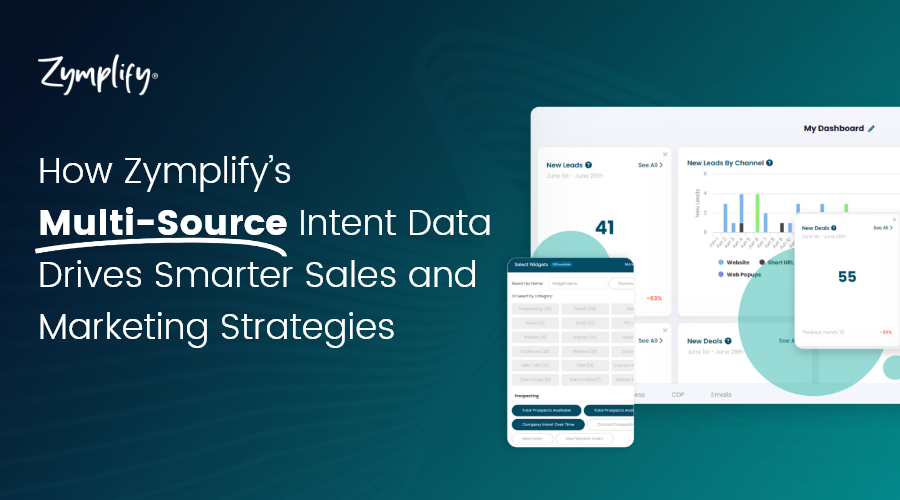Finding and engaging the right prospects has always been a challenge for B2B companies, especially as buyer behaviour becomes increasingly complex. Intent data offers a powerful solution, helping businesses gain visibility into customer needs and interests early in the buying process.
In a recent interview, Peter Eakin, Head of Sales at Zymplify, shared valuable insights on the power of intent data and how Zymplify is redefining customer acquisition for businesses.
What is Intent Data?
Intent data allows companies to predict which businesses are likely interested in their products or services by analysing signals that indicate purchase intent. Traditionally, intent data often took the form of third-party signals, such as online content consumption spikes related to specific topics.
Today, intent data includes multiple forms:
- First-party sources: Anonymous visitors to your website
- Second-party sources: Visits to review sites or engagement on social media channels
- Brand interactions: Email clicks, social media follows, and other brand engagements
With 80% of B2B buying decisions now made before any interaction with sales, businesses need to reach potential customers during their independent research phase. Intent data has become essential for sellers aiming to meet buyers where they are and provide the information they seek.
The Benefits and Limitations of Traditional Contact Data
Traditional contact data, such as email addresses or phone numbers, remains valuable, offering businesses a direct line to potential customers. Contact data enables teams to connect with potential leads, ensuring that outreach efforts are targeted and intentional.
However, contact data alone can lack the nuance needed to understand a buyer’s stage in the purchasing journey or specific interests. Integrating contact data with multi-source intent data provides a comprehensive view of potential customers, allowing for a more targeted approach.
“Companies still need to get in front of their target audience, but intent data adds precision that contact data alone can’t provide.”
– Peter Eakin, Head of Sales at Zymplify
The Challenges of Relying on Single-Source Intent Data
Single-source intent data, though widely used, often falls short in capturing the complexity of buyer research. Relying on a single data source can lead to missed opportunities and wasted outreach efforts due to “false flags.”
Some of the key challenges include:
- Complex Buyer Journeys: Buyers research products through various channels, including search, social media, brand content, and personal networks. Single-source intent data may not capture the full picture, resulting in leads that look promising but don’t actually translate into sales.
- Vendor Reliance: Using a single data source means becoming dependent on one vendor, leaving businesses vulnerable to price increases or data saturation as more competitors tap into the same signals.
- Missed Signals: Single-source intent data may indicate that a company is researching a topic but can miss critical signals, such as the company also researching a competitor’s product. This lack of visibility limits the accuracy of sales teams’ outreach.
What is Multi-Source Intent Data?
Multi-source intent data overcomes these limitations by capturing a broader range of signals throughout the buying journey.
While single-source solutions focus on one activity (for example, researching a topic), multi-source intent data tracks multiple signals, such as:
- Website visits
- Competitor research
- Case study downloads
- Product reviews and comparisons
With this broader scope, businesses can better identify which companies are genuinely interested and in-market. Zymplify’s platform pieces together these various signals, giving sales teams a complete view of buyer intent for more precise and effective outreach.
The Cost and Complexity of Multi-Source Intent Data
Traditionally, accessing multi-source intent data required multiple SaaS subscriptions, each costing thousands per year, along with the challenge of integrating these platforms. Managing multiple platforms can add complexity for sales teams and reduce efficiency.
Zymplify simplifies this process by offering a single, all-in-one solution that consolidates intent data from multiple providers, including Bombora, Continuity, and Foundry. With one subscription, one platform, and one integration point, businesses eliminate complex integrations and reduce costs.
“With Zymplify, you get intent data from seven sources with a single subscription—solving both cost and complexity challenges.”
– Peter Eakin, Head of Sales at Zymplify
How to Use Multi-Source Intent Data Across Business Functions
Zymplify’s multi-source intent data can enhance various business functions, allowing teams to use insights in ways that support growth across departments.
Businesses can use multi-source intent data for:
- Customer Acquisition: Identify leads actively researching relevant solutions, allowing for targeted, productive outreach.
- Paid Marketing: Direct ads to in-market accounts, optimising ad spend and improving ROI by reaching the right audiences.
- Content Strategy: Use intent insights to identify trending topics and create content addressing potential customers’ needs.
- Sales Development: SDRs can prioritise leads with clear intent signals, increasing the likelihood of successful outreach.
- Account Management: Account managers can detect early signs of churn or upselling opportunities, helping maintain strong customer relationships.
Multi-source intent data empowers every team responsible for growth by providing richer insights into the behaviours, needs, and preferences of potential and existing customers.
Learn More About Zymplify’s Intent Data Capabilities
For businesses ready to explore the power of multi-source intent data, we offer several ways to get started. Scheduling a call with one of our data consultants is the best way to identify key companies showing intent and develop a tailored strategy to accelerate your growth.
If you’re not yet ready to speak with our team, you can still explore our solutions at your own pace by trying the hands-on demo experience that allows you to see Zymplify in action. by plugging in general information about your target audience and products.




